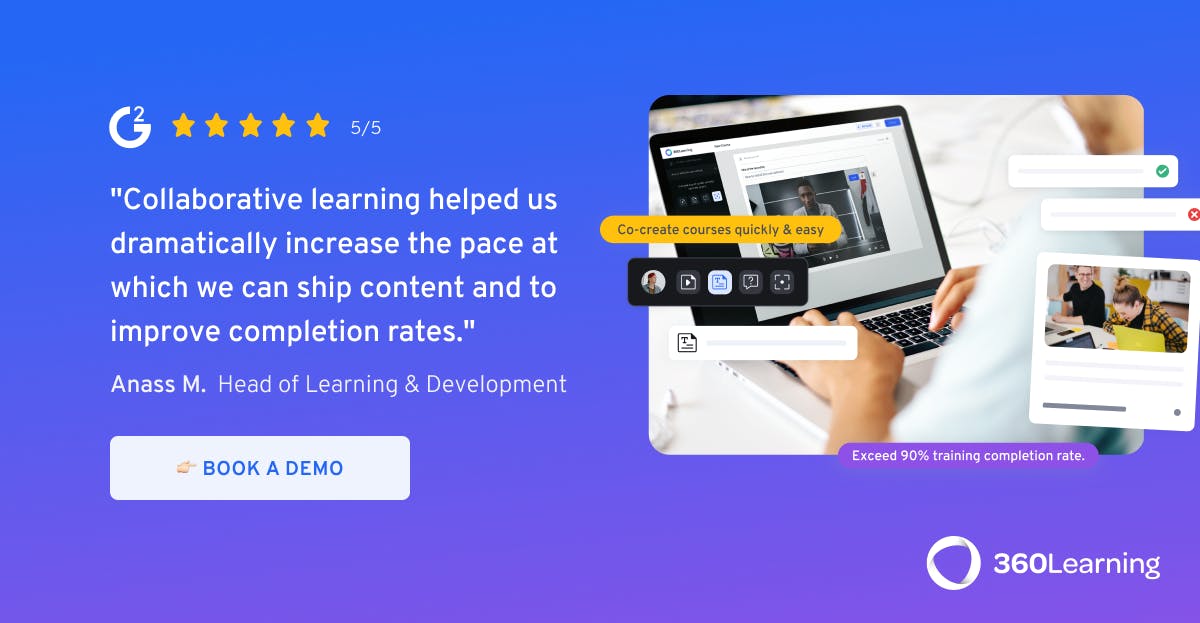What Is Collaborative Learning Theory and Why Do You Need It?
According to Harvard Business Review, the number of collaborative activities we perform at work has increased by 50% in the past two decades. The recent rise in remote work has made communication in the workplace more vital than ever.
Yet, many organizations’ go-to training models focus on individual learning. There’s clearly a disconnect here—how do we bridge the gap?
As the workplace changes, L&D needs to catch up. That’s where Collaborative Learning Theory comes in. Collaborative Learning Theory is one learning theory that can make your L&D efforts more relevant and engaging.
Collaborative Learning Theory ties into these developments in workplace culture by emphasizing teamwork and human interaction. By applying it to your L&D program, you can promote better team play in every area of your workplace. (For those eager to learn more, our Collaborative Learning ebook goes into even more detail—check it out below).
What is Collaborative Learning Theory?
Collaborative Learning Theory is based on the notion of Collaborative Learning, a learning methodology in which employees and instructors gain knowledge from each other. It follows these assumptions about learning:
- Learning is social at its core. People learn from each other by talking about their current knowledge and solving problems together.
- Learning is an active process. People learn best when they work with information in meaningful ways.
- Learning depends on its subject matter’s context. Learners get the most out of new information when they apply it as they learn it.
- Learners come from a wide range of knowledge backgrounds. Everyone brings a unique perspective to learning environments that offer new knowledge to other learners and teachers.
When you approach L&D through this framework, learning reflects employee priorities more closely than the traditional top-down, classroom model. Your L&D courses will look more like the communicative and collaborative activities that we increasingly see in the workplace.
Collaborative Learning Theory practices for your L&D program
Collaborative Learning Theory makes a great foundation for your high-level L&D structure, but you’ll need to dig into its methodologies to put it into practice. Many of these concepts work well in online learning—an increasingly vital tool in L&D.
Problem-focused learning
During problem-focused learning, learners apply their knowledge together to solve a problem. The social nature of this side-by-side collaboration opens the door for participants to pick up new skills, perspectives, and facts from their collaborators. The practice ties back to Collaborative Learning Theory’s core ideas of learning as an active process and learning in context.
When team members collaborate to solve a problem using new information, they also build skills in decision-making, conflict resolution, and practical application in their training topic. Employees use these abilities in the workplace every day, and problem-focused learning strengthens them.
Problem-focused learning can also help employees retain the information they learn during training. Scientific research shows that active types of learning like problem-focused learning are more effective than traditional, passive learning activities. People observe and imitate each other during active learning, stimulating their mirror neurons.
What does problem-focused learning look like in L&D? Try training methods like collaborative projects, case study discussion, and simulations.
Peer learning
Peer learning involves learners teaching each other subject material by building online courses, adding information to content, and asking and answering questions. The workplace provides an ideal environment for peer learning where employees can democratize L&D through peer training. In a peer training framework, all employees rely on each other’s expertise to learn, going back to Collaborative Learning Theory’s concept of social learning.
Workplaces that have coaching cultures put peer training at the core of their L&D. They have a collaborative onboarding process where new team members learn from a community of colleagues instead of a single mentor. All employees get to propose new learning topics and contribute to lessons.
One of the most popular examples of peer learning in the workplace is peer review or feedback loops. In this approach to learning, employees give each other objective and constructive feedback on their performance.
Learning communities
A learning community is an L&D program structure designed to connect knowledge subjects and learners for a more cohesive educational experience. In one of these communities, learning happens inside and outside the classroom. This L&D structure touches on many of Collaborative Learning Theory’s foundations, including social learning and shared perspectives.
You’ll mostly see the concept of learning communities explored in schools, but you can also structure your workplace to create a Learning Organization. Learning Organizations are organizations that focus on continual and active learning to engage employees. They give team members guidance while leaving room for self-directed and Collaborative Learning.
You can also think of a workplace learning community as a learning ecosystem where everyone learns in harmony. In a learning ecosystem, leadership guides and coaches employees instead of reinforcing a strict hierarchy. Everyone in a learning ecosystem has a unique role that contributes to the greater whole.
Democratized learning
In a democratized learning environment, anyone can share or request knowledge for the group as a whole, connecting to Collaborative Learning Theory’s principle of shared expertise. There are no designated teachers—instead, everyone is a learner.
This concept slightly overlaps with peer learning, but while peer learning is a practice, democratized learning is an L&D program framework. It subverts the traditional top-down learning structure in L&D, where a trainer leads and trainees follow.
One way to promote democratized learning in your organization is to share institutional knowledge throughout your team. When you make those resources accessible, you’ll break down information silos in your workplace that get in the way of learning. Your team members will have access to the exact resources they need when they need them.
You can also democratize workplace learning by revamping your training needs analysis process. In a bottom-up training needs analysis, the learner suggests courses and topics for their L&D program. This approach enables L&D professionals to provide content that team members find meaningful.
360Learning: A learning platform for Collaborative Learning
One of the easiest ways to incorporate Collaborative Learning Theory in your L&D program is to adopt a Collaborative Learning platform like 360Learning. 360Learning’s features touch on these Collaborative Learning Theory concepts we discussed today:
- Problem-focused learning: 360Learning has flexible integrations and authoring tools that empower you to build problem-solving into every lesson. Interactive features like course forums let learners tackle problems together.
- Peer learning: Learners can score and react to each other’s courses for fast and effective peer feedback. In 360Learning, anyone can create a course, including employees in different departments.
- Learning communities: Create public and private learning groups that connect team members through the subjects they learn. Learners can work together to create a course thanks to collaborative course authorship features.
- Democratized learning: Any team member can declare a Learning Need—a course they want to learn from their colleagues. A knowledgeable peer can respond directly to the request and make a course in 360Learning.
See the power of Collaborative Learning in L&D for yourself. Ask for a fully customized 360Learning demo today.




